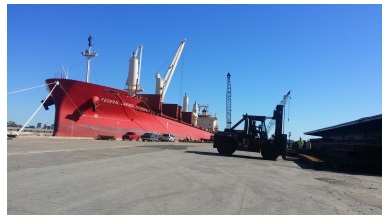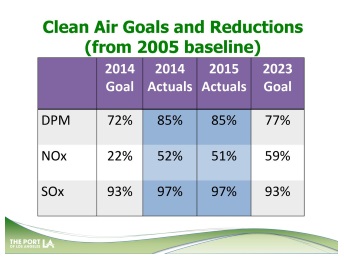

Port of Los Angeles Continues to Improve Air Quality in Southern California
The 2015 Inventory of Air Emissions released last week shows the Port of Los Angeles has largely continued to preserve clean air gains that have reduced key pollutants, lowered health risk in surrounding communities and improved the quality of life in the greater Los Angeles area.
"Our clean air strategies were put to the test with the backlog of ships we experienced in the first part of 2015, and we largely held our ground," said Port Executive Director Gene Seroka. "With this temporary situation behind us, we expect to see clean air progress when the numbers come in for 2016."
Overall, diesel particulate matter (DPM) emissions remain down an unprecedented 85 percent from all sources related to port operations, replicating the Port’s record set in 2014. Likewise, sulfur oxides (SOx) emissions are down 97 percent, nearing total elimination. Nitrogen oxides (NOx) emissions are down 51 percent, just 1 percent shy of the 52 percent reduction rate in 2014.
The detailed inventory’s latest findings are based on data collected during calendar year 2015 and reviewed by regional, state and federal air regulatory agencies. The baseline is 2005, the year before the landmark San Pedro Bay Clean Air Action Plan (CAAP) was adopted. The results show the port continues to exceed its 2023 targets for reducing DPM and SOx (77 percent and 93 percent respectively) and is within striking distance of its 2023 target of reducing NOx emissions 59 percent.
The port also held the line on reducing the health risk of port-related emissions by lowering them 85 percent. That level sustains the progress achieved in 2014 when the port hit its 2020 target.
In addition to criteria pollutants like NOx, SOx and DPM, the Port also tracks greenhouse gas (GHG) emissions, which contribute to global warming and are associated with climate change. The 2015 emissions inventory shows that GHG emissions were 10 percent below the 2005 baseline, but the 2015 GHG emissions were higher than Port GHG emissions in 2014, when they were 16 percent below the 2005 baseline. The increased 2015 GHG emissions are mostly attributable to congestion issues experienced in the first part of 2015. With congestion now behind it, the Port anticipates a return to larger GHG emissions reductions for 2016, as the Port continues in its efforts to achieve California’s goal of reducing GHGs 80 percent by 2050, based on 1990 levels.

Photo/The Port of Los Angeles